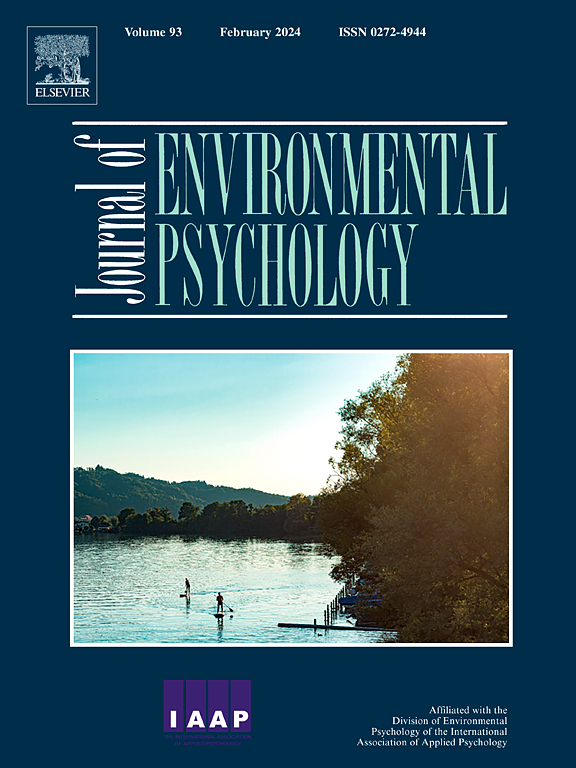Stairs as multifunctional spaces: Cortical responses to environmental affordances incorporate the intention to act
IF 6.1
1区 心理学
Q1 ENVIRONMENTAL STUDIES
引用次数: 0
Abstract
Urban planning and design principles would benefit from enhanced understanding of how public spaces afford engagement. Place affordances refer to the behaviours that the architecture of a place enables the perceiving agent to enact and are incorporated into the early stages of human perceptual processes. However, less is known about how an agent's action intentions are integrated into the perception of affordances. In the present study, we presented participants with images of an architectural structure featuring lateral and central staircases with either high or low steps whilst recording brain activity with electroencephalography (EEG). Participants were primed to consider either reading a book, or meeting friends in the places, and were asked to rate the appropriateness of the places for the given activity and to select the location within the scene where they would conduct that activity. There was also a control condition with no primed activity that involved aesthetic ratings of the same places. Behavioural ratings showed that high steps were preferred for reading compared to low steps whereas step height was not a significant factor for conducting a social activity. Participants preferred the lateral stairs to read on, but shifted to the central stairway when the high steps were central with low steps on the lateral sides. In contrast, participants preferred the central stairway to conduct a social activity in all stair configurations. The EEG data showed no significant differences between the two activity conditions in early perceptual processes. However, pronounced differences in early brain dynamics were observed when participants judged places for activities compared to aesthetics. Specifically, latencies of the visual evoked P1 component were shorter and amplitudes were reduced for the aesthetic ratings, which also yielded larger P2 and P300 amplitudes, signifying modulation of perceptual and attentional processes for the exact same stimuli, by the intention to act. These results demonstrate the importance of human action intentions in the environment when considering place affordances.
求助全文
约1分钟内获得全文
求助全文
来源期刊

Journal of Environmental Psychology
Multiple-
CiteScore
10.60
自引率
8.70%
发文量
140
审稿时长
62 days
期刊介绍:
The Journal of Environmental Psychology is the premier journal in the field, serving individuals in a wide range of disciplines who have an interest in the scientific study of the transactions and interrelationships between people and their surroundings (including built, social, natural and virtual environments, the use and abuse of nature and natural resources, and sustainability-related behavior). The journal publishes internationally contributed empirical studies and reviews of research on these topics that advance new insights. As an important forum for the field, the journal publishes some of the most influential papers in the discipline that reflect the scientific development of environmental psychology. Contributions on theoretical, methodological, and practical aspects of all human-environment interactions are welcome, along with innovative or interdisciplinary approaches that have a psychological emphasis. Research areas include: •Psychological and behavioral aspects of people and nature •Cognitive mapping, spatial cognition and wayfinding •Ecological consequences of human actions •Theories of place, place attachment, and place identity •Environmental risks and hazards: perception, behavior, and management •Perception and evaluation of buildings and natural landscapes •Effects of physical and natural settings on human cognition and health •Theories of proenvironmental behavior, norms, attitudes, and personality •Psychology of sustainability and climate change •Psychological aspects of resource management and crises •Social use of space: crowding, privacy, territoriality, personal space •Design of, and experiences related to, the physical aspects of workplaces, schools, residences, public buildings and public space
 求助内容:
求助内容: 应助结果提醒方式:
应助结果提醒方式:


